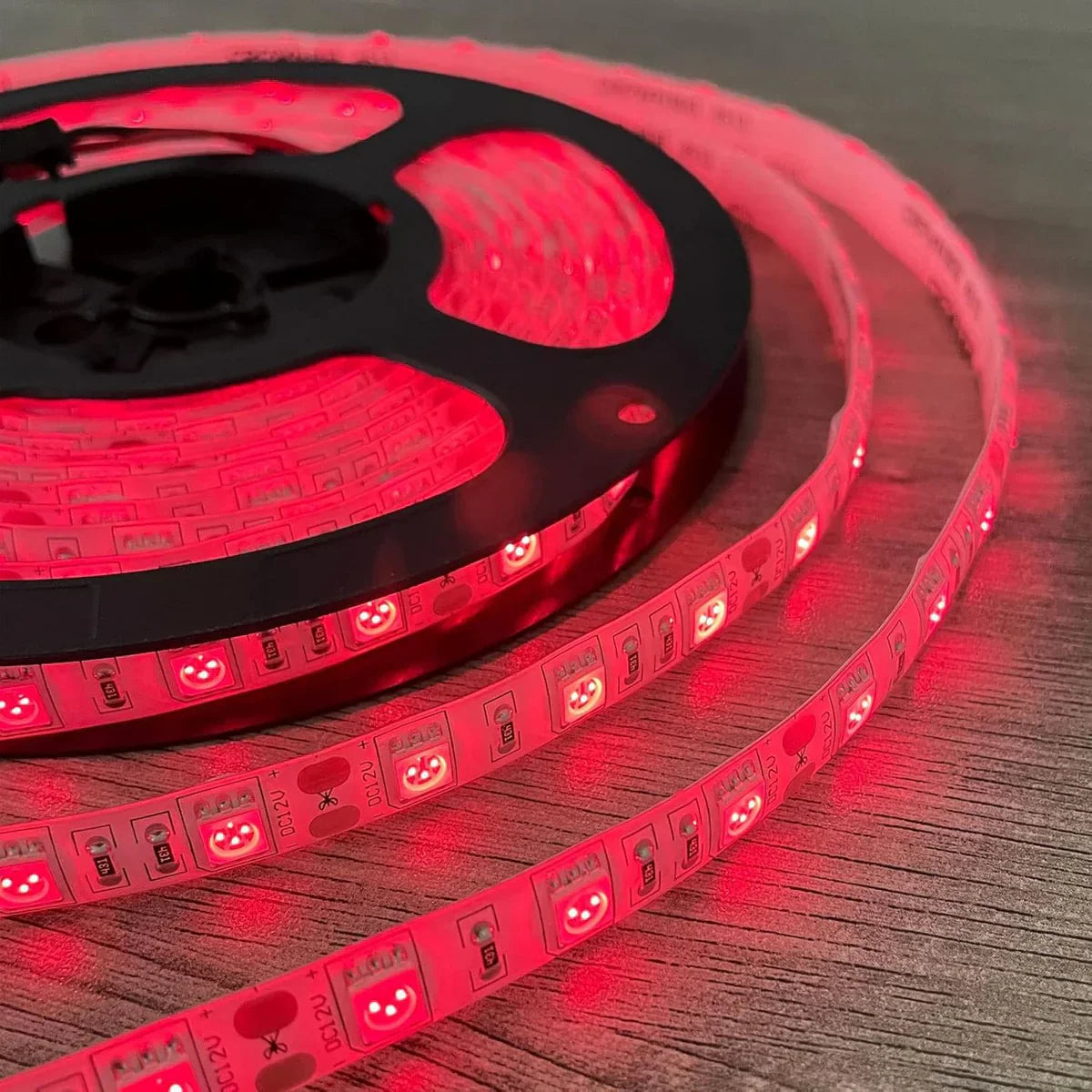Beyond the range of human vision lies an entire “invisible spectrum.”
Infrared light (IR) is one of the most practical wavelengths within it — unseen by the eye but sensed by cameras, sensors, plants, and even human tissue. This makes it widely used in scientific research, security systems, healthcare, and industrial lighting.
With the emergence of Infrared LED Strips (IR LED Strips), infrared light is no longer confined to specialized instruments. It is now available in flexible, efficient, and durable strip forms that can be integrated into countless real-world applications.
This article dives into the working principles of infrared LEDs, the differences between key wavelengths, and how to select the right model for specific projects.
I. From Visible to Invisible: The Principle and Classification of Infrared Light
Infrared light covers a wavelength range of approximately 635 nm to 940 nm, lying between visible red light and microwaves.
Within this range, different wavelengths of infrared light vary in penetration depth and interaction properties — making each ideal for distinct applications.
| Wavelength Range | Visibility | Typical Applications |
|---|---|---|
| 635 nm | Visible red | Indicators, decorative lighting, signage |
| 660–670 nm | Deep red (high visibility) | Photobiomodulation, red light therapy, plant growth |
| 730–735 nm | Near infrared (low visibility) | Photoperiod control, flowering stimulation in plants |
| 810 nm | Near infrared (invisible) | Near-IR therapy, deep tissue stimulation |
| 850 nm | Infrared (invisible) | Night vision, surveillance lighting, IR sensors |
| 940 nm | Infrared (invisible) | Camera IR filters, remote controls, IR imaging |
These LED strips typically use SMD2835 and SMD5050 packages powered by 12V DC, combining high brightness with low energy consumption, excellent heat dissipation, and long lifespan.
II. Research and Laboratory Lighting: Precision in Infrared Control
In laboratory environments, infrared light is widely used for spectral analysis, thermal imaging, material testing, and sensing systems.
Compared to traditional halogen sources, IR LED strips offer faster response times, cleaner spectral output, and higher control precision.
For example, the SMD2835 810nm Infrared Strip provides stable near-infrared output for medical and phototherapy research,
while the SMD5050 850nm High-Brightness Strip delivers powerful illumination for imaging and detection systems.
For multi-band research, the Multi-Wavelength Rigid IR Strip (635–940nm) enables continuous spectral lighting within a single strip, perfect for comparative analysis and calibration.
III. Security and Night Vision: The Unseen Light That Protects
Infrared LED strips play a vital role in security and night vision systems, particularly in the 850nm and 940nm ranges.
The 850nm SMD2835 IR Strip emits light invisible to the human eye but highly visible to IR cameras — ideal for night surveillance, motion sensors, and infrared triggers.
Meanwhile, the 940nm SMD2835 Invisible IR Strip is completely invisible, making it suitable for covert monitoring and sensitive optical environments.
In industrial or outdoor systems, the SMD5050 940nm High-Power Strip provides superior output and heat management — a standard for infrared supplementary lighting.
All these products support IP65 waterproofing, ensuring reliable operation in both indoor and outdoor conditions.
IV. Health and Rehabilitation: Light Therapy and Circulation Enhancement
The biological effects of infrared light have been extensively verified through research.
In particular, 660nm (red) and 810nm (near-infrared) wavelengths are known to enhance cellular metabolism, promote microcirculation, and relieve muscle fatigue.
The SMD2835 660–670nm Red Strip is widely used in home phototherapy devices, rehabilitation systems, and cosmetic panels,
while the SMD5050 810nm Near-IR Strip penetrates deeper into tissue to support blood flow and muscle recovery.
Flexible in design, these strips can easily adhere to curved surfaces,
making them an ideal infrared light source for medical equipment manufacturers and wellness technology brands.
V. Plant Lighting and Agriculture: The Hidden Helper in Growth Control
Infrared light doesn’t just benefit humans — it also plays an important role in plant biology.
Plants absorb different infrared wavelengths through chlorophyll and phytochrome receptors to regulate growth cycles and flowering.
The SMD2835 730–735nm IR Strip is commonly used in greenhouses and hydroponic systems to help plants detect “day length,”
while the SMD5050 730–735nm High-Power Strip provides high-intensity far-red light to promote flowering and increase yield.
When paired with the SMD2835 660–670nm Red Strip, the combination forms a complete red + far-red spectrum,
allowing precise control of plant growth, blooming, and fruiting cycles.
VI. Choosing the Right Infrared Wavelength: Quick Reference Guide
| Wavelength Range | Main Applications | Product Links |
|---|---|---|
| 635 nm | Visible red, indicators and decoration | 2835 635nm Red Strip | 5050 635nm Bright Red Strip |
| 660–670 nm | Red light therapy, plant growth | 2835 660nm Red Strip | 5050 660nm High-Power Red Strip |
| 730–735 nm | Photoperiod and flowering control | 2835 730nm IR Strip | 5050 730nm IR Strip |
| 810 nm | Therapy and tissue repair | 2835 810nm IR Strip | 5050 810nm IR Strip |
| 850 nm | Night vision and security lighting | 2835 850nm IR Strip | 5050 850nm IR Strip |
| 940 nm | Covert monitoring, sensors | 2835 940nm IR Strip | 5050 940nm IR Strip |
VII. Conclusion
Though invisible to the human eye, infrared light has deeply integrated into our daily life and modern technology.
From security and monitoring to healthcare and agriculture, IR LED strips have become the silent core of “invisible illumination,” combining flexibility, energy efficiency, and precise performance.
In the future, with the advancement of AI vision, smart agriculture, and wearable health technology, the application scope of infrared lighting will continue to expand.
When we talk about “smart lighting,” it’s no longer limited to visible light — it also means mastering the invisible spectrum.
Infrared LED Strips — extending the boundary of light into the unseen future.

